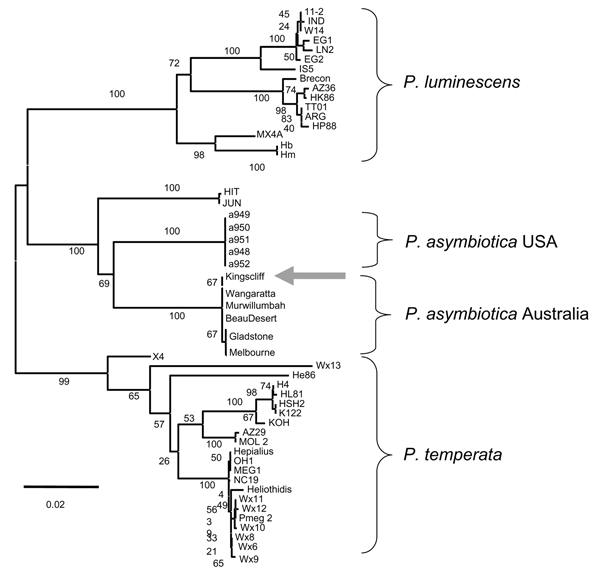Volume 12, Number 10—October 2006
Dispatch
Nematode Symbiont for Photorhabdus asymbiotica
Figure 2

Figure 2. Phylogenetic tree of concatenated sequences of fragments of the glnA gene (474 bp) and the gyrB gene (576 bp) in 52 Photorhabdus isolates representing known diversity across the genus. The tree was constructed with the neighbor-joining algorithm and the K2-P method of distance estimation as implemented in MEGA version 3.0 (12). A total of 1,000 bootstrap replicates were performed, and the percentage of bootstrap trees supporting each node are given. The Kingscliff isolate (arrow) clusters with P. asymbiotica isolates from Australia, both in the concatenated tree (bootstrap score = 100%) and in individual gene trees (not shown). The scale bar shows percentage relatedness.
References
- Woolhouse ME, Gowtage-Sequeria S. Host range and emerging and reemerging pathogens. Emerg Infect Dis. 2005;11:1842–7.PubMedGoogle Scholar
- Waterfield NR. Wren BW, ffrench-Constant RH. Invertebrates as a source of emerging human pathogens. Nat Rev Microbiol. 2004;2:833–41. DOIPubMedGoogle Scholar
- Read TD, Peterson SN, Tourasse N, Baillie LW, Paulsen IT, Nelson KE, The genome sequence of Bacillus anthracis Ames and comparison to closely related bacteria. Nature. 2003;423:81–6. DOIPubMedGoogle Scholar
- Parkhill J, Wren BW, Thomson NR, Titball RW, Holden MT, Prentice MB, Genome sequence of Yersinia pestis, the causative agent of plague. Nature. 2001;413:523–7. DOIPubMedGoogle Scholar
- Fischer-Le Saux M, Viallard V, Brunel B, Normand P, Boemare N. Polyphasic classification of the genus Photorhabdus and proposal of new taxa: P. luminescens subsp. luminescens subsp. nov., P. luminescens subsp akhurstii subsp.nov., P. luminescens subsp. laumondii subsp. nov., P. temperata subsp.nov. and P. asymbiotica sp.nov. Int J Syst Bacteriol. 1999;49:1645–56. DOIPubMedGoogle Scholar
- Akhurst R, Smith K. Regulation and safety. In: Gaugler R, editor. Entomopathogenic nematology. Wallingford (UK): CAB International; 2002. p. 311–32.
- Farmer JJ, Jorgensen JH, Grimont PAD, Ackhurst RJ, Poinar GO, Ageron E, Xenorhabdus luminescens (DNA hybridization group 5) from human clinical specimens. J Clin Microbiol. 1989;27:1594–600.PubMedGoogle Scholar
- Gerrard J, Waterfield N, Vohra R. ffrench-Constant, R. Human infection with Photorhabdus asymbiotica: an emerging bacterial pathogen. Microbes Infect. 2004;6:229–37. DOIPubMedGoogle Scholar
- Weissfeld AS, Halliday RJ, Simmons DE, Trevino EA, Vance PH, O'Hara CM, Photorhabdus asymbiotica, a pathogen emerging on two continents that proves that there is no substitute for a well-trained clinical microbiologist. J Clin Microbiol. 2005;43:4152–5. DOIPubMedGoogle Scholar
- Urwin R, Maiden MC. Multi-locus sequence typing: a tool for global epidemiology. Trends Microbiol. 2003;11:479–87. DOIPubMedGoogle Scholar
- Maiden MC, Bygraves JA, Feil E, Morelli G, Russell JE, Urwin R, Multilocus sequence typing: a portable approach to the identification of clones within populations of pathogenic microorganisms. Proc Natl Acad Sci U S A. 1998;95:3140–5. DOIPubMedGoogle Scholar
- Kumar S, Tamura K, Nei M. MEGA3: Integrated software for molecular evolutionary genetics analysis and sequence alignment. Brief Bioinform. 2004;5:150–63. DOIPubMedGoogle Scholar
- Joyce SA, Burnell AM, Powers TO. Characterization of Heterorhabditis isolates by PCR amplification of segment of the mtDNA and rDNA genes. J Nematol. 1994;26:260–70.PubMedGoogle Scholar
- White GF. A method for obtaining infective nematode larvae from cultures. Science. 1927;66:302–3. DOIPubMedGoogle Scholar
- Taylor MJ, Bandi C, Hoerauf A. Wolbachia bacterial endosymbionts of filarial nematodes. Adv Parasitol. 2005;60:245–84. DOIPubMedGoogle Scholar
Page created: November 10, 2011
Page updated: November 10, 2011
Page reviewed: November 10, 2011
The conclusions, findings, and opinions expressed by authors contributing to this journal do not necessarily reflect the official position of the U.S. Department of Health and Human Services, the Public Health Service, the Centers for Disease Control and Prevention, or the authors' affiliated institutions. Use of trade names is for identification only and does not imply endorsement by any of the groups named above.